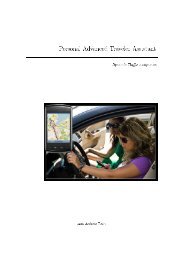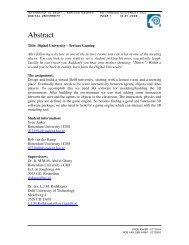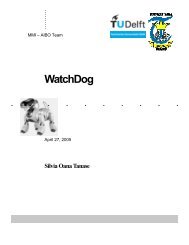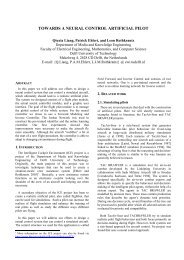Recognition of facial expressions - Knowledge Based Systems ...
Recognition of facial expressions - Knowledge Based Systems ...
Recognition of facial expressions - Knowledge Based Systems ...
You also want an ePaper? Increase the reach of your titles
YUMPU automatically turns print PDFs into web optimized ePapers that Google loves.
ecognition in static pictures, for three separate <strong>facial</strong> <strong>expressions</strong> plus the neutral class.<br />
Three algorithms are presented: the template-based determined by computing the average<br />
face for each emotion class and then performing matching <strong>of</strong> one sample to the templates,<br />
the multi-layered perceptron trained with the back-propagation <strong>of</strong> error algorithm and a<br />
neural algorithm that uses six odd-symmetric and six even-symmetric Gabor features<br />
computed from the face image. According the authors, the template-based approach<br />
presented 75% correct classification while the generalization achieved only 50%, the<br />
multilayered perceptron has 40% to 80% correct recognition, depending on test the data<br />
set. The third approach did not provide an increase in the performance <strong>of</strong> the <strong>facial</strong><br />
expression recognition.<br />
Several research works study the <strong>facial</strong> dynamics <strong>of</strong> recognition <strong>of</strong> <strong>facial</strong> <strong>expressions</strong>.<br />
The work <strong>of</strong> [Yacoob and Davis, 1994] uses optical flow to identify the direction <strong>of</strong> rigid<br />
and non-rigid motions shown by <strong>facial</strong> <strong>expressions</strong>. The results range from 80% for<br />
sadness to 94% for surprise emotion on a set <strong>of</strong> 46 image sequences recorded from 30<br />
subjects, for six <strong>facial</strong> <strong>expressions</strong>.<br />
Some attempts to automatically detect the salient <strong>facial</strong> features implied computing<br />
descriptors such as scale-normalized Gaussian derivatives at each pixel <strong>of</strong> the <strong>facial</strong><br />
image and performing some linear-combinations on their values. It was found that a<br />
single cluster <strong>of</strong> Gaussian derivative responses leads to a high robustness <strong>of</strong> detection<br />
given the pose, illumination and identity [Gourier et al., 2004]. A representation based on<br />
topological labels is proposed [Yin et al., 2004]. It assumes that the <strong>facial</strong> expression is<br />
dependent on the change <strong>of</strong> <strong>facial</strong> texture and that its variation is reflected by the<br />
modification <strong>of</strong> the <strong>facial</strong> topographical deformation. The classification is done by<br />
comparing <strong>facial</strong> features with those <strong>of</strong> the neutral face in terms <strong>of</strong> the topographic <strong>facial</strong><br />
surface and the expressive regions. Some approaches firstly model the <strong>facial</strong> features and<br />
then use the parameters as data for further analysis such as expression recognition. The<br />
system proposed by [Moriyama et al., 2004] is based on a 2D generative eye model that<br />
implements encoding <strong>of</strong> the motion and fine structures <strong>of</strong> the eye and is used for tracking<br />
the eye motion in a sequence. As concerning the classification methods, various<br />
- 16 -
















